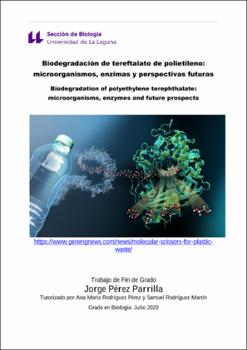Biodegradación de tereftalato de polietileno: microorganismos, enzimas y perspectivas futuras.
Autor
Pérez Parrilla, JorgeFecha
2020Resumen
Hoy en día, el problema medioambiental generado por la acumulación de residuos plásticos afecta a todo tipo de ecosistemas, alterándolos y causando multitud de efectos negativos en los seres vivos (seres humanos incluidos). Tal es la gravedad del problema que, en los últimos años, se han propuesto multitud de posibles tratamientos para reducir la cantidad de estos residuos, mitigando sus efectos nocivos. El uso de microorganismos para degradar plásticos supone una de las soluciones más prometedoras, constituyendo una vía económica y respetuosa con el medio natural. En este trabajo, centramos nuestra atención en la biodegradación del tereftalato de polietileno (PET), uno de los poliésteres de uso más extendido, destacando algunos microorganismos y enzimas involucrados en este proceso. Asimismo, se discutirán distintos enfoques para solventar las limitaciones de algunas de las enzimas y se describirá la estructura y el mecanismo molecular de las enzimas PETasa y MHETasa, producidas por Ideonella sakaiensis. Pretendemos pues, llevar a cabo una breve descripción de los hallazgos más relevantes obtenidos en la última década con el fin de ofrecer una visión del estado actual y perspectivas futuras de la biodegradación del PET. Nowadays, the environmental problem generated by the accumulation of plastic waste affects all kinds of ecosystems, altering them and causing a multitude of negative effects on living beings (including humans). Such is the seriousness of the problem that, in recent years, a multitude of possible treatments have been proposed to reduce the amount of this waste, mitigating its harmful effects. The use of microorganisms to degrade plastics is one of the most promising solutions, constituting an economic and environmentally friendly way. In this work, we focus our attention on the biodegradation of polyethylene terephthalate (PET), one of the most widely used polyesters, highlighting some microorganisms and enzymes involved in this process. Likewise, different approaches will be discussed to overcome the limitations of some of the enzymes and the structure and molecular mechanism of the PETase and MHETase enzymes, produced by Ideonella sakaiensis, will be described. We intend, therefore, to carry out a brief description of the most relevant findings obtained in the last decade in order to offer a vision of the current state and future perspectives of the biodegradation of PET.





